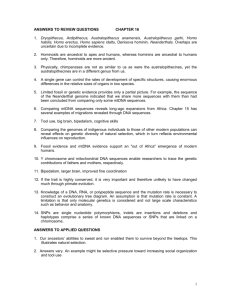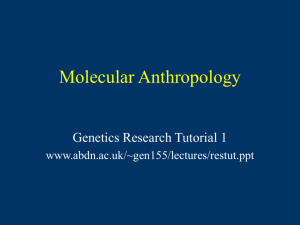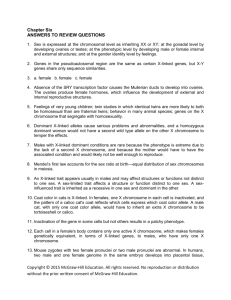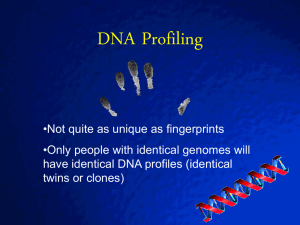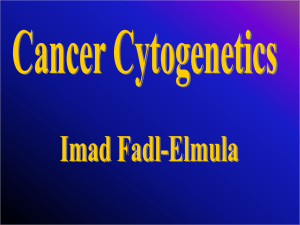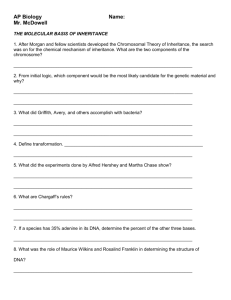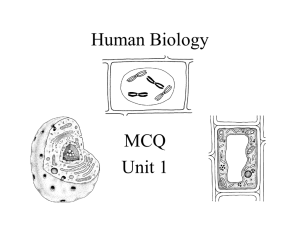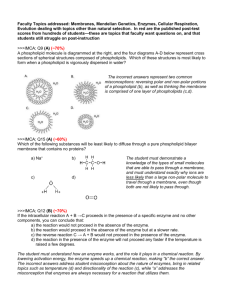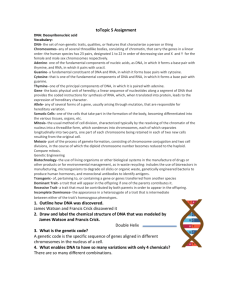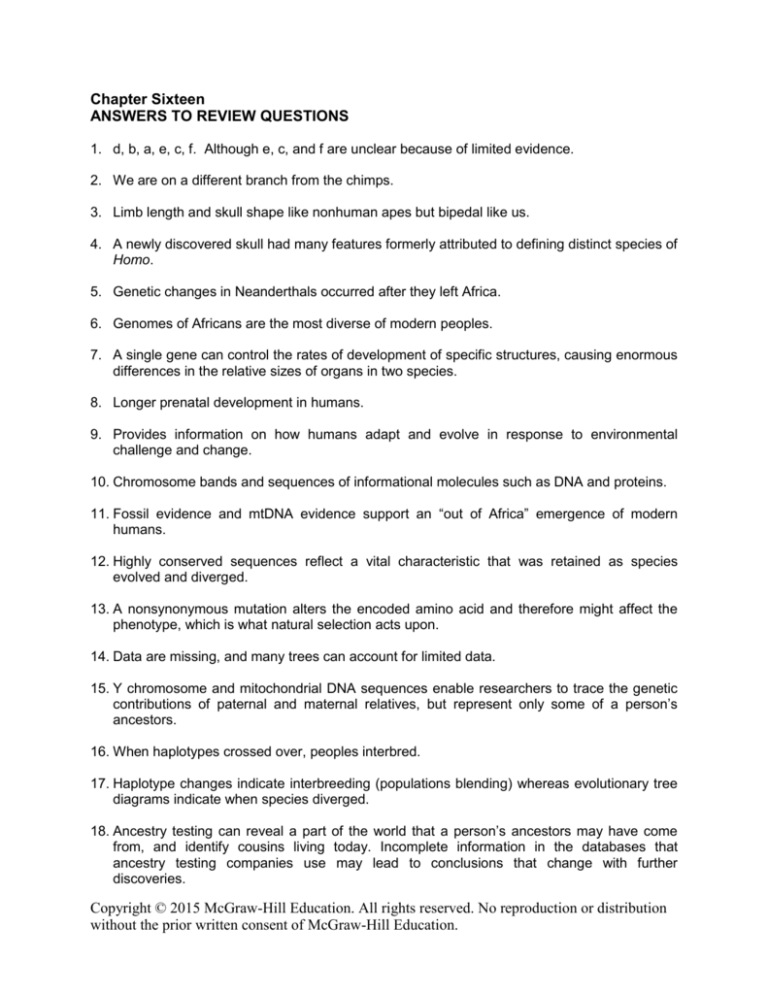
Chapter Sixteen
ANSWERS TO REVIEW QUESTIONS
1. d, b, a, e, c, f. Although e, c, and f are unclear because of limited evidence.
2. We are on a different branch from the chimps.
3. Limb length and skull shape like nonhuman apes but bipedal like us.
4. A newly discovered skull had many features formerly attributed to defining distinct species of
Homo.
5. Genetic changes in Neanderthals occurred after they left Africa.
6. Genomes of Africans are the most diverse of modern peoples.
7. A single gene can control the rates of development of specific structures, causing enormous
differences in the relative sizes of organs in two species.
8. Longer prenatal development in humans.
9. Provides information on how humans adapt and evolve in response to environmental
challenge and change.
10. Chromosome bands and sequences of informational molecules such as DNA and proteins.
11. Fossil evidence and mtDNA evidence support an “out of Africa” emergence of modern
humans.
12. Highly conserved sequences reflect a vital characteristic that was retained as species
evolved and diverged.
13. A nonsynonymous mutation alters the encoded amino acid and therefore might affect the
phenotype, which is what natural selection acts upon.
14. Data are missing, and many trees can account for limited data.
15. Y chromosome and mitochondrial DNA sequences enable researchers to trace the genetic
contributions of paternal and maternal relatives, but represent only some of a person’s
ancestors.
16. When haplotypes crossed over, peoples interbred.
17. Haplotype changes indicate interbreeding (populations blending) whereas evolutionary tree
diagrams indicate when species diverged.
18. Ancestry testing can reveal a part of the world that a person’s ancestors may have come
from, and identify cousins living today. Incomplete information in the databases that
ancestry testing companies use may lead to conclusions that change with further
discoveries.
Copyright © 2015 McGraw-Hill Education. All rights reserved. No reproduction or distribution
without the prior written consent of McGraw-Hill Education.
19. Vertebrates: complex neural networks, blood clotting, acquired immunity. Humans: speech,
walking upright, running.
20. We can affect our evolution by altering the environment and treating conditions that are
inherited or have an inherited component that otherwise would prevent reproduction.
ANSWERS TO APPLIED QUESTIONS
1. Australopithecines and Homo migrated. Mutations occurred in Neanderthals in Europe. The
ancestors of Native Americans underwent a population bottleneck (genetic drift). Many
waves of people migrated out of Africa, over many years. Mutations gave us distinctly
human traits. Natural selection favored a long prenatal period in humans.
2. Fossil evidence is very fragmented, and many types of organisms might not have left fossil
evidence.
3. Australopithecines could not travel far. Homo was able to travel more and populations mixed
and interbred.
4. a. A small duplication occurred in human chromosome 11 to give rise to the Betazoid
karyotype. The Klingon and Romulan karyotypes could have arisen from fusion
of
human chromosomes 15 and 17.
b. The Betazoids are our closest relatives because of greater similarity in chromosome
bands and chromosome arrangement. Cytochrome C sequences and intron pattern in
the collagen gene are identical between humans and Betazoids.
c. They are not distinct species because they can interbreed.
d. 3
5. Yes, based on the mtDNA evidence.
6. The pygmies are the older, indigenous group. Males from the agricultural groups had
children with female pygmies.
7. The pale-skinned Ethiopians might be regarded as beautiful and therefore more likely to
have children. Pale skin may be linked to a beneficial trait. Skin damage doesn’t kill people
before they can reproduce.
8. Travel
ANSWERS TO WEB ACTIVITIES
1. Answers vary with indigenous group selected.
2. a. Only limited lineages are traced.
b. By testing a sample from a brother, father, or other male from the paternal line.
c. Opinion.
Copyright © 2015 McGraw-Hill Education. All rights reserved. No reproduction or distribution
without the prior written consent of McGraw-Hill Education.
ANSWERS TO FORENSICS FOCUS
1. Profiling a suspect.
2. a – d opinion.
ANSWERS TO CASE STUDIES AND RESEARCH RESULTS
1. Opinion about right to privacy of DNA testing on deceased members of an indigenous
people, and informed consent before DNA testing of living people.
2. Some modern humans share up to four percent of their DNA with Neanderthals.
3. DNA analysis.
4. Africa to Western Asia and Europe. Spain and Portugal through Northern Africa.
Anthropological evidence.
5. Geographic regions indicated by a haplogroup may not reflect particular ethnic or racial
groups, which are social, not genetic.
6. mtDNA and Y chromosome haplogroups
7. Language came from the paternal line.
8. a. Divergence of ancestral humans and chimps. Divergence of modern humans
from archaic humans. Divergence of modern human populations.
b. The similarities support current hypotheses regarding primate and human evolution.
c. The divergence of old world and new world lice varieties. Anthropological evidence of
contact between archaic and modern humans.
Copyright © 2015 McGraw-Hill Education. All rights reserved. No reproduction or distribution
without the prior written consent of McGraw-Hill Education.

